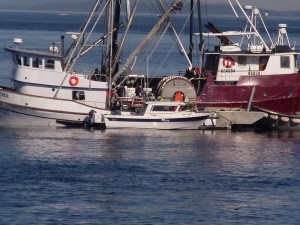One fish, two fish. . . No more fish?
 Concerns about overfishing are a pressing issue. Technological advances, have made fishing industries much more efficient. Fish are caught at greater depths, and in much larger numbers. Some scientists have estimated that as much as 90% of large predatory fish including sharks, swordfish, and cod have been removed from the oceans of the world . With so many large predatory fish having been removed from the ocean it may seem that there are plenty of other fish in the sea, however this is untrue for a growing number of fish populations. Other factors, including pollution, fishing methods, and habitat destruction contribute to the decline of many fish populations, including Chinook salmon.
Concerns about overfishing are a pressing issue. Technological advances, have made fishing industries much more efficient. Fish are caught at greater depths, and in much larger numbers. Some scientists have estimated that as much as 90% of large predatory fish including sharks, swordfish, and cod have been removed from the oceans of the world . With so many large predatory fish having been removed from the ocean it may seem that there are plenty of other fish in the sea, however this is untrue for a growing number of fish populations. Other factors, including pollution, fishing methods, and habitat destruction contribute to the decline of many fish populations, including Chinook salmon.
As we have learned, Chinook are the preferred prey of the endangered southern resident killer whales. These salmon are also listed as endangered. Habitat degredation, genetic and ecological impacts from hatchery production, and impacts from hydropower are factors that put these fish at risk. While Chinook salmon make up 65 % of the southern resident killer whales diet, and are of upmost importance to this population of killer whales, they are also consumed by many other marine animals. As specific fish populations become threatened or endangered, so do the predators that depend on them as a food source.
Understanding relationships between predators and their prey is crucial to maintaining, and sustaining the environment in which all living creatures share. Establishing the importance of all members contributing to an ecosystem further emphasizes the importance of practicing sustainability. It is important to remember that the environment in which we live is delicate and can be manipulated easily. It is up to all members of society to establish methods for fishing that will not devastate the environment in which they live, and share.



 Twitter
Twitter LinkedIn
LinkedIn Facebook
Facebook